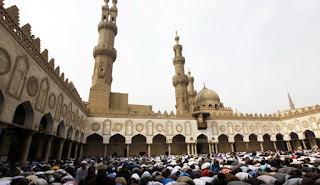If one were to judge Egypt by it's appearance, climate and General location, many would not imagine Egypt to be a major producer of much of anything in the ancient world. Desert condition on the Western side of the country, rough mountainous terrain in the South and swampy marshlands along the Nile River Valley. What could possible come out these areas? The answer is surprisingly a lot!
Ancient Egypt's main natural resource was Gold. Gold was mainly harvested from gold laden rocks along the Nile River. This resource provided Egypt with power, they were revered for their Gold production by friendly countries whilst hated by their enemies. Gold was used in nearly everything in Egypt, from sculptures, temples, clothing, jewelry, currency, wall decor and sarcophagi, whenever an Egyptian could afford to use gold it was used.
Golden Sarcophagus of King Tutankhamen
Among the other, perhaps less coveted resources in ancient Egypt was their salt mines. Egypt mined natron, brine and soda salts. These salts gave Egyptians a variety of uses flavoring and preservation of food, the ability to tan animal hide, as well a a key component of the mummification process. The salts were also used for medicines, mouthwashes and when mixed with oil, it could be used as soap.
Salted Hanging Fish
Sandstone, and Limestone were abundant in ancient Egypt. This was incredibly important for building. Large blocks of stone could be hauled off and easily chiseled and carved into necessary shapes with hand tools.
Temple of Ramses II – 19th Dynasty (c. 1240 BC) sandstone
Wood in Egypt was not as abundant. What little wood could be gathered was not strong enough and too knotted to be used for decent structural support, so it was used in furniture making, also as material used in making coffins and for fire wood.
AN EGYPTIAN REVIVAL MOTHER OF PEARL-INLAID SOLID ROSEWOOD STOOL
Two of the most important plants that grew in massive amount in the very fertile lands along the Nile were Fax and Papyrus. Flax was used as oil(fuel) and more importantly it was used for its fiber. This fiber was made into material for clothing as well as blankets and textiles. Papyrus provided Egyptians with one of the most important tools in their history; writing paper. Papyrus was used to record and store anything that Egyptians could write about their culture, and most importantly their medical knowledge and mathematical studies. PPS considers believes Papyrus gave Egypt "sophistication"(PPS, 2006)
Ancient Egyptian Papyrus
In modern day Egypt, with the use of modern technology, oil and gas production are among the nations top resources. In fact it accounts for nearly "55% of the countries economy in 2006-2009"(NRGI, 2015). Egypt currently produces approximately 270 million barrels of oil per year. Natural gas production is also on the rise. In the ancient world Gold was the top resource, in modern day Egypt there remains only two open gold mines, the Sukari and the Hamash mines. Resources indicate that Gold production might be making a come back with approximately 120 new gold mines ready for exploration.
Egypt's position geographically provided the country with the most ideal position for trade with other countries. With the modern Suez Canal, Egypt has become a hub for international trade flowing from the east and west.
Egyptian Oil Field
Sources:
Uknown. "Natural Resources." PBS. March 15, 2006. Accessed June 5, 2015.http://www.pbs.org/empires/egypt/newkingdom/resources.html
Uknown. "Natural Resources." PBS. March 15, 2006. Accessed June 5, 2015.http://www.resourcegovernance.org/countries/middle-east-and-north-africa/egypt/extractive-industries
Unknown. "Domestic Trade." Ancient Egypt: Domestic Trade. 2003. Accessed June 5, 2015.http://www.reshafim.org.il/ad/egypt/trade/internal_trade.htm
Images:
Golden Sarcophagus of King Tutankhamen
Marseille, Marc.Well Preserved Corpses.November 5, 2011.Acecabana, Web:http://www.acecabana.com/world’s-well-preserved-corpses/
Salted Hanging Fish
Unknown. Salted-Hanging-Fish. 2015. Beyond the Shaker, Web: http://beyondtheshaker.com/pages/Salt-Guide-History.html
Temple of Ramses II – 19th Dynasty (c. 1240 BC) sandstone
Simbel, Abu. Temple of Ramses II- 19th Dynasty (c.1240BC) Sandstone.Wikipedia-New Kingdom of Egypt.http://www.kingsacademy.com/mhodges/05_World-Cultures/02_Ancient-Civilization/02b_Egypt.htm
AN EGYPTIAN REVIVAL MOTHER OF PEARL-INLAID SOLID ROSEWOOD STOOL
Christies. AN EGYPTIAN REVIVAL MOTHER OF PEARL-INLAID SOLID ROSEWOOD STOOL. April 16, 2009. SALE 2157 —EUROPEAN FURNITURE, WORKS OF ART, TAPESTRIES AND CARPETS.http://www.christies.com/lotfinder/furniture-lighting/an-egyptian-revival-mother-of-pearl-inlaid-solid-5192089-details.aspx?from=searchresults&intObjectID=5192089&sid=e7f288bc-e192-41a3-891f-ea6c94c9388d
Ancient Egyptian Papyrus
Unknown. Ancient Egyptian Papyrus. January 2014. Ancient Egyptian Facts: Papyrus; Web:http://www.ancientegyptianfacts.com/ancient-egyptian-papyrus.html
Egyptian Oil Field
Zaidi, Asad/Bloomberg.(No Title). March 31, 2015. Apache has pumped almost 1 million barrels of oil from its Egypt fields since November, Fuel Fix, Web:http://fuelfix.com/blog/2015/03/31/apache-has-pumped-almost-1-million-barrels-of-oil-from-its-egypt-fields-since-november/#30267101=0





















